BCS Stories
Sports broadcasters rely on game changing technologies
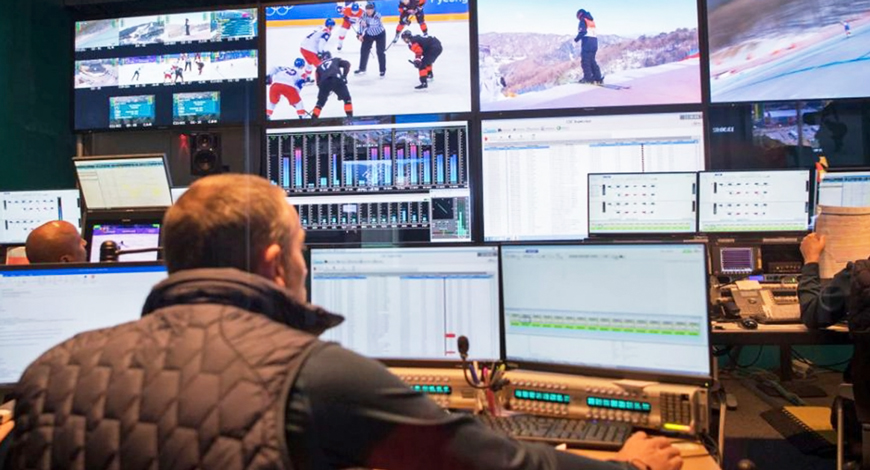
The COVID-19 pandemic has resulted in squeezing into twelve months what in pre-pandemic times would have been years of transformational change in the live production space. The limitations imposed by social distancing have forced broadcasters to rethink the way they produce live content, with an acceleration of the adoption of remote production. With so many live events cancelled in 2020, many took the opportunity to initiate transformational projects during a quiet period. At the same time, suppliers are rethinking how to deliver projects as a result of restricted travel.
In 2020, one of the sports broadcast industry’s most dependable components, the live sport fixture list, was completely upended. This specific component is worth noting for a discussion on sports broadcast because so much relies on the certainty of the list. Contracts are signed, jobs are staffed, and media narratives are all dependent on the fixtures taking place and the subsequent broadcast coverage. In response, the industry found ways to be increasingly flexible in 2020.
The industry has found ways to increasingly provide remote coverage of sport. New workflows have been developed – which are increasingly software-defined – for visual storytelling and financial models have been tinkered with as a result of these alterations. All of this was done out of necessity, yet it is unlikely all of it to go away once the industry returns to normal.
Technology truly sits at the heart of how broadcasters can adapt to growing demand for sport across the globe, driven in part by the continuing pandemic and further lockdowns. The onus now sits on sports broadcasters to keep fans engaged with their favorite teams or sports stars via intuitive solutions that can match the ever-growing demand for content.
2021 is set to be another truly transformative and challenging year for the sports broadcasting industry, with software, rather than hardware, driving further innovations. While it remains to be seen whether fans will be allowed to attend sporting events in 2021, technological applications in 2020 have proven that personalized and memorable fan experiences can be delivered remotely.
Advancements have allowed innovations such as fan walls, where videos of fans help to provide a match-day atmosphere for both athletes and other fans. There will also be more of what OTT platforms can provide, with a marked shift toward the use of cloud and IP technologies to power their growing potential. The increased sophistication of OTT platforms and greater competition in the market will pave the way for these experiences to be delivered, providing an advantage over traditional means of television. Further opportunities will arise for instant replay, interactive video panning, travelling, zooming and audio options that can be tailored to each viewer.
The uptake of technology-based solutions such as virtual meetings, remote training, remote configuration, and testing has proved positive in increasing project efficiency and effectiveness. The momentum behind all these trends is so strong that they will continue well into 2021 and beyond, even as the impact on production of the pandemic subsides.
Software is the solution going forward
As the focus has been on how to deliver the production with a remote team, the resulting output of the production has not actually changed that much. This, of course, is a success for the change with the method of delivery. One of the most important concepts is that broadcasters must no longer be dependent on hardware. Software-defined visual storytelling is the future. If they can move to software and data center or cloud-based solutions, they are not tied to the physical locations of hardware. And that is absolutely critical to respond to changes – to the fixture list or otherwise.
This is not just a consideration for creativity’s sake nor for budgetary considerations – although, as noted, it definitely helps. Rather, this is a new form of fault tolerance. The industry must be prepared to respond swiftly if the physical locations ever become unworkable in the future.
With software, broadcasters will be ready. They are more flexible, more resilient, more efficient, and more creative – all without losing the professional quality viewers have come to expect from us in sports broadcasts. The industry is not just adapting anymore, it is evolving.
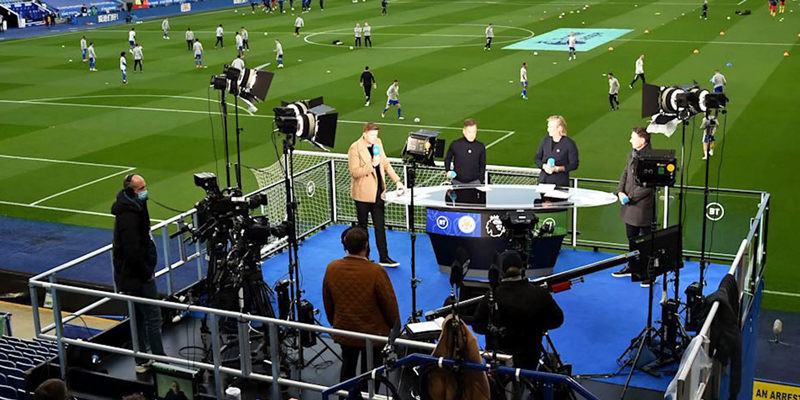
The role of 5G and edge computing
There has been a lot of discussion about how 5G will impact broadcasting in general and sports broadcasting in particular. This includes making remote production more practical and reducing the carbon footprint for broadcasters. 5G will enable new broadcasting techniques that will overcome some of the limitations of 4G. For the first time, sports broadcasters can guarantee available bandwidth, for example.
Beside increasing the efficiency of remote production and improving sustainability, 5G is also set to transform the fan experience and offer new ways of enjoying sports. With 5G technology bringing higher video quality and reduced latency, there are increased possibilities to deliver immersive and interactive user experiences, inside and outside stadiums and sports arenas.
There are high expectations on what 5G can deliver for sports broadcasting and media, and the broadcasting industry is looking forward to being a part of this development.
When it comes to volumetric video, 5G will mean a fully rendered three-dimensional footage can reach audience instantaneously due to 5G’s incredibly low latency period and huge bandwidth capabilities.
And the collaborative work of 5G Edge-XR is opening up whole new areas of possibility when it comes to edge computing.
Right now, most applications use processors built into a device to stream an image. For some of the future immersive experiences, even the latest devices struggle with the workload required. When wearable devices begin to be used, they will need to be lightweight. Offloading the processing power to remote computers ensures the weight can be limited and the style of this new generation of wearable devices can be improved.
The 5G Edge-XR consortium allows the sports broadcasters to render augmented reality content on graphics processing units deployed within the 5G network. The processed footage, which is of a much better quality than the graphics rendering capabilities of a handheld or wearable device, are then sent to the viewers with the help of the low latency capabilities of 5G.
The combination of 5G and edge computing means huge amounts of real-time data, like the digitized broadcast of a football match, travels smaller distances at a greater speed, and without being affected by other devices also trying to stream the same data.
It entirely changes what broadcast providers and networks could provide the subscribers. And it allows broadcasters to work with another dimension when it comes to experience as a viewer.
Production and multiple screens
Sport is best enjoyed live. Therefore, the production of live sport events needs to be on point and highly engaging. But as matches and competitions have come back to screens after the first lockdowns in 2020, there is a noticeable change in the productions. The production teams are not just capturing the action happening on the fields and courts anymore but are also creating a more personalized experience for the fans.
There will be most likely an evolution of how broadcasters use different feeds to cover different points of views throughout a live broadcast. Multiple feeds and alternative camera angles allow for enhanced storytelling with different the points of view. A perfect and well-known example is the celebration cam explored by the Premier League, a fixed point at the side of the goal, which does not require a camera operator, intended to encourage players to communicate their celebration to fans watching at home.
The right content in the right place and creating interaction
When creating a cohesive multi-screens strategy for sports broadcasting, each piece of content has to be relevant for its audience and for the channel it is being exposed in. A good example of this, is broadcasters investing in creating short form content, with fast turnaround post-production, close to live events, which can be published almost instantly to enable social media interaction around a live broadcast.
With small or non-existent audience at sports events as a result of the pandemic, it has become even more important to create interaction for virtual audiences. The NFL is, for example, using Microsoft Teams to let fans virtually attend games. With the help of virtual mirrors in the form of large-scale LED screens, appear in each end zone during the games, players are allowed to celebrate with fans sitting at home. The same content will also be used in the television broadcast with fans appearing on-screen together with a player who scored.
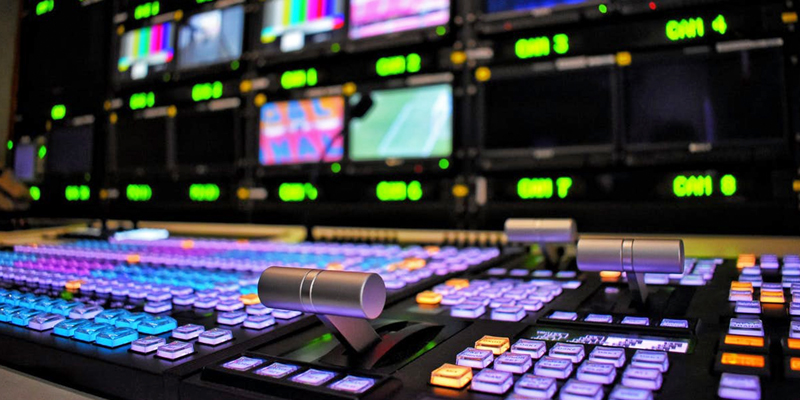
Virtualization is here to stay
When sport first started to return, there were efforts to reintroduce fans to otherwise empty stadiums. Powerful render engines offering photo realism and compositing capabilities became crucial. Is it here to stay? It seems likely that the idea of bringing fans from far away into the game in unique ways is worth discussion. Creating more connections with fans – even virtually – will always be a valuable component to live sport and sport broadcasts.
That said, these render engines also allowed for some exciting teleportation techniques where individuals on two separate green screens can be placed together on a single virtual set. This can be done in a single studio, in two studios within a single campus, or even up to time zones away. It also allowed for athletes to be digitally transported to a live studio in another city.
Advancing supporting technologies – such as cameras linked together with advanced robotics and more robust IP networks – will be important to ensure these use cases develop. But the capability to offer this virtualization is here and it should prove itself in multiple creative capacities moving forward.
Creating atmosphere in empty stadia
The resumption of live elite sport in 2020 highlighted the issue of empty stadia when it comes to the viewer experience. For many, the lack of a crowd detracts considerably from the excitement. Alongside the option of adding crowd noise, broadcasters have been experimenting with some interesting ways to enhance the experience by adding augmented and virtual reality feeds.
There have also been some interesting examples of adding real time fan commentary and streamed video of fans to create stadium atmosphere. In one example, basketball’s NBA displayed live web cam feeds from remotely attending celebrity viewers and fans on big screens around the court.
These have worked well in some instances, most notably in the National Basketball Association’s (NBA) bubble games that closed out the final games of the 2019-20 season and playoffs. It was great to see this kind of innovation, albeit underpinned by a lot of behind-the-scenes work (in terms of production and logistics) to ensure viewers’ high expectations were met.
AI in sports
Artificial intelligence looks set to revolutionize the way sports storytelling is done. Using machine learning and deep learning algorithms, broadcasters can automate numerous videomaking operations, including camera shooting and zooming in on key field actions.
According to PwC, AI-based tools are already being deployed in virtually all major sports disciplines, such as American football, soccer, baseball, and cricket, but also non-professional leisure activities like grassroots sports.
Among these tools, one can count sensors, wearables, and computer vision-powered cameras to collect athletes’ performance data. At the same time, natural language processing devices can leverage speech and text recognition to gather insights regarding the audience’s sentiment.
All this information will be processed by machine learning (ML) and deep learning (DL) systems to create forecast models and assist coaches and managers through their decision-making, or to automate numerous processes related to broadcasting and fan experience.
Considering the holistic role of AI in sports, it should come as no surprise that the technology market linked to this sector was already worth USD 8.9 billion in 2018, and may reach USD 31.1 billion by 2024 with a CAGR of 20.63 percent, according to MarketsAndMarkets.
Among the potential reasons for this sharp development, there is an increasing level of public involvement, the expanding demand for decision making but also a plain and simple growth in the number of sporting events. These factors lead sports companies to invest increasing sums in AI implementation, data analytics, and machine learning consulting.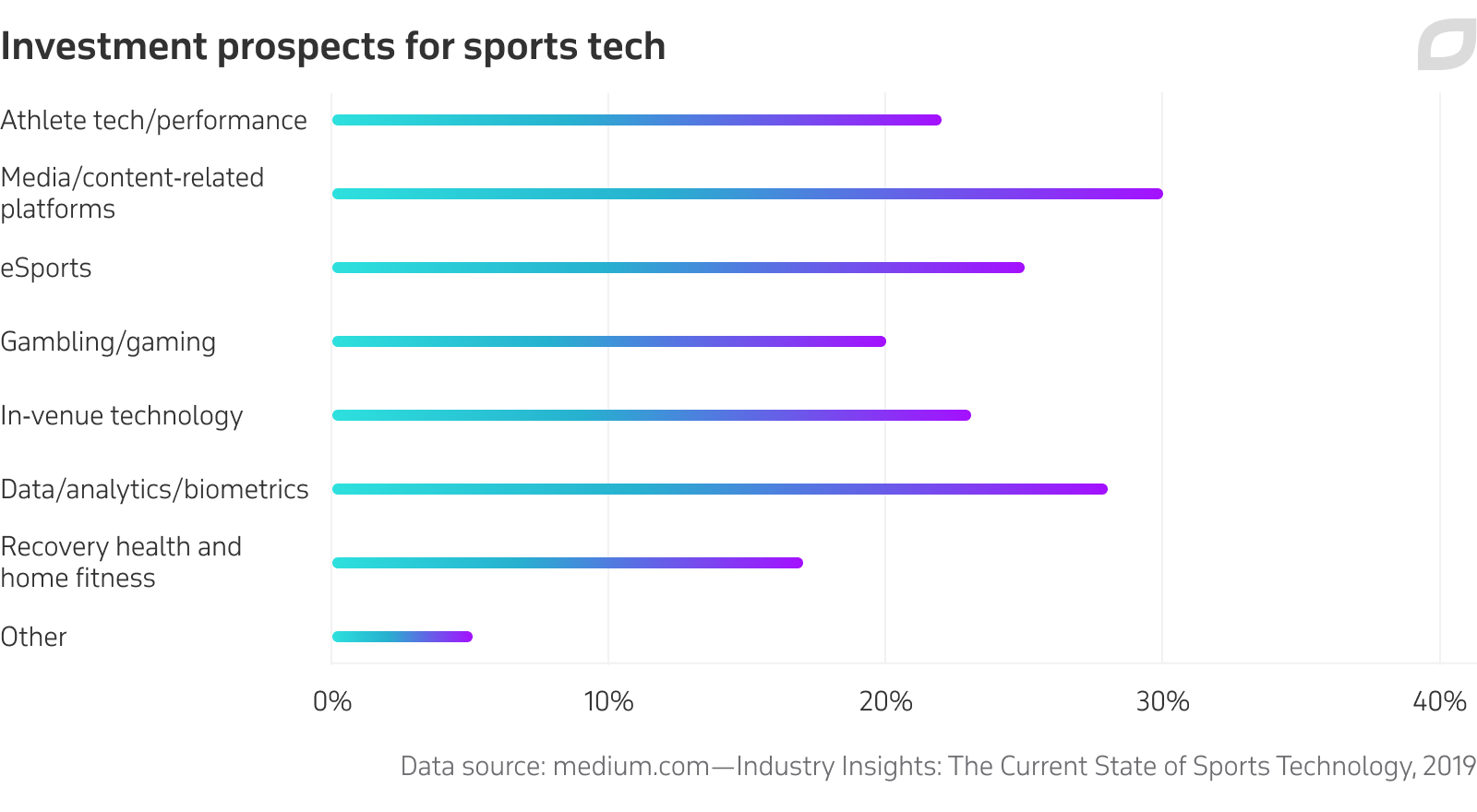
Fully automated sports production is already almost comparable to professionally edited videos. A similar solution was developed by IBM Watson for Wimbledon 2019. Their ML-based system was able to identify the highlights of each match by analyzing fan reactions, balls’ trajectory and rebounds, and other types of acoustic and visual data. Based on these insights, the AI chose the most exciting shots to be broadcast on television and the internet.
A similar trend is occurring with sports journalism, thanks to recent innovations in the field of natural language processing. Of course, news writing is unlikely to be 100 percent automated anytime soon. So, sports reporters can breathe a sigh of relief!
But something is already moving, with AI-powered tools integrated into content creation for the sports press. That is exactly what The Associated Press did in 2018, leveraging an AI-based platform to quickly turn NCAA basketball game data into brief news reports. Thanks to this system, it is possible to cover many more events while deploying fewer resources.
Additionally, machine learning algorithms allow broadcasting companies to pinpoint game highlights by taking into account players’ actions and fans’ emotional responses. Such insights are invaluable for advertisers to choose the proper time for commercials and better grab the attention of their audiences.
The new norms
This means the norms of production must be questioned. Could broadcasters move from large OB trucks to smaller production trucks? Can the industry look at new workflows where a production team brings the ISOs back to a central location and produces the PGM feed from there? With flexible access to software-defined visual storytelling tools, one can still offer pre-shows, halftime shows, analysis, stats, and live commentary – all done remotely. There is no compromise. Thus, when the senior director is talking about budgets for 2021, this is now a far more realistic consideration.
Further, this connects right back to the fixture list. With matches being considered perpetually in flux until kickoff, having a staff that is flexible to change their assignment from a home or remote workspace is huge and reduces risk. The passion is the game. It is not the location. The industry is coming to terms with that right now.
Payment models
At the end of 2020, every broadcaster of live sport is reassessing how it pays and plans for services. Subscription models that allow broadcasters to use production tools and services when they need them will become more important moving forward. Flexible access and pay-per-use will be increasingly common terms used when manufacturers discuss long-term plans with broadcast partners.
The industry had been discussing such a subscription model for some time. That said, those discussions were at a simmer. The global pandemic has accelerated that need. Paying for services and hardware all up front is likely a practice of the past. With the way budgets will be constructed in 2021, this is a topic no longer on the back burner.
Why? It all comes down to risk. The risk profile of sports has changed forever with the loss of the concrete fixture list. Thus, the way broadcasters price that risk is changing as well.
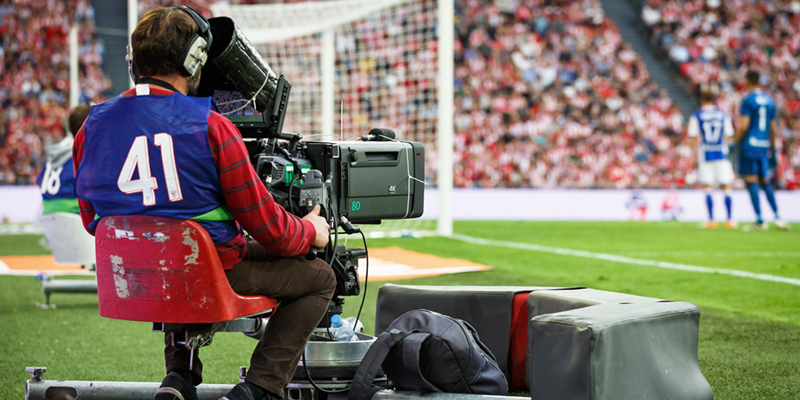
Way forward
With necessity the mother of invention, it is important to take these (and other) learnings into 2021 and continue to think out of the box. Whether that is looking at new distribution models, augmenting linear channels, or developing new approaches to production. In doing so, the industry will be turning live sports events into true media and entertainment showcases, something that will stand it in good stead as social distancing regulations look likely to keep fans out of stadiums for some time.
The pandemic has created many challenges, but also an abundance of opportunity for sports content owners and broadcasters to develop their propositions. Technology, as much as viewing behaviors, continue to change the game – whether it’s 5G or AR, there’s ever increasing opportunity for innovation. Personalization and interactivity are becoming increasingly important for creating engaging viewing experiences in sports.
By definition though, experiments can fail. When broadcasters are looking for returns on major sporting investments, there is certainly an element of risk in doing so. The key is to experiment around production, while ensuring the basics of acquisition and delivery are handled brilliantly (and reliably).
Audience experiences aside, there remains a very real threat that many planned events would not go ahead. Despite the best efforts of governing bodies, broadcast partners and others, scheduling in a pandemic is something of a matter of guesswork, and multiple programming contingencies are needed to fill gaps in the schedule when (and if) things do not go to plan.
This requires something of a cultural shift to ensure broadcasters and rights holders become comfortable with uncertainty. For this to happen, they will need to be confident in their ecosystem and supply chains. This means that their aggregation, media processing, and distribution partners have the technology, the expertise and, crucially, the ambition to adapt to changing circumstances with both agility and confidence. In short, it is a matter of trust.









You must be logged in to post a comment Login